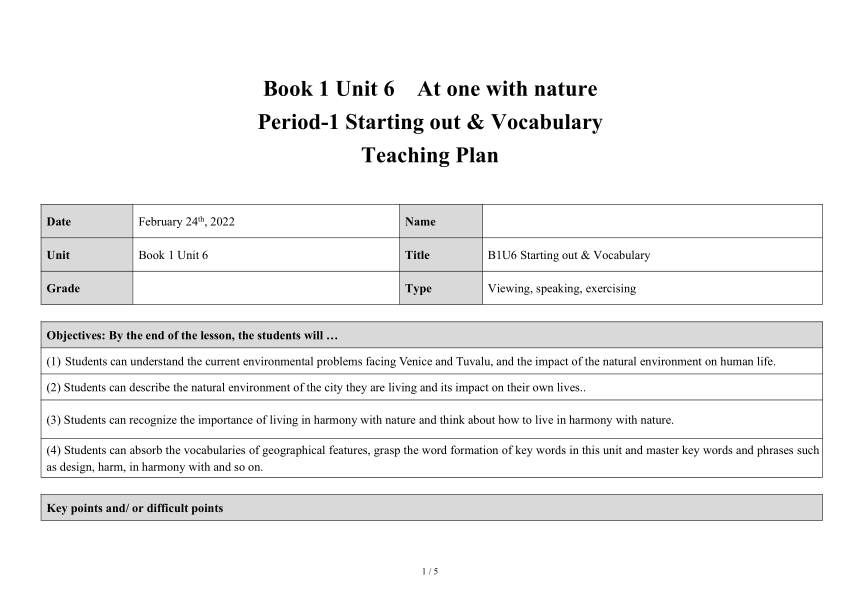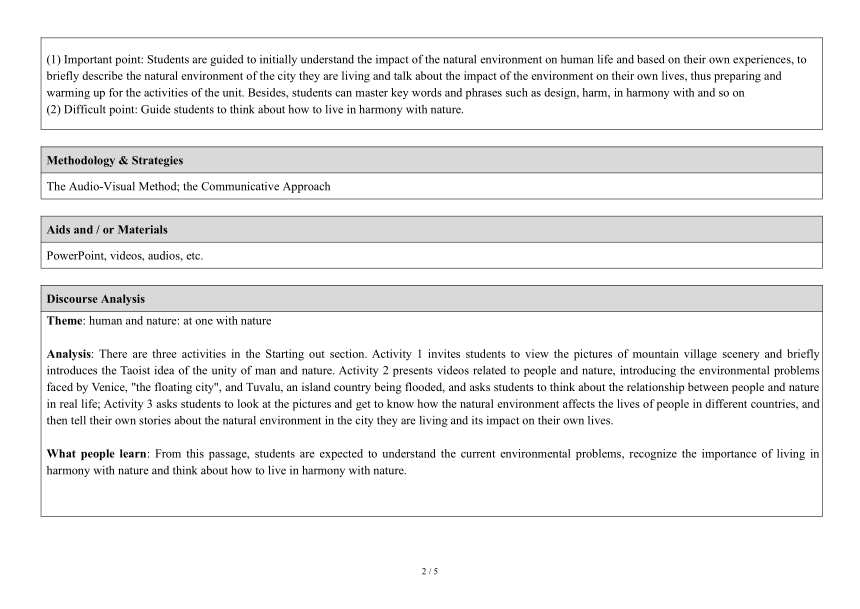外研版(2019)高中英语必修第一册 Unit 6 At one with nature Starting out and Vocabulary 名师教学设计
文档属性
| 名称 | 外研版(2019)高中英语必修第一册 Unit 6 At one with nature Starting out and Vocabulary 名师教学设计 |  | |
| 格式 | docx | ||
| 文件大小 | 27.3KB | ||
| 资源类型 | 教案 | ||
| 版本资源 | 外研版(2019) | ||
| 科目 | 英语 | ||
| 更新时间 | 2023-02-26 13:57:00 | ||
图片预览


文档简介
Book 1 Unit 6 At one with nature
Period-1 Starting out & Vocabulary
Teaching Plan
Date February 24th, 2022 Name
Unit Book 1 Unit 6 Title B1U6 Starting out & Vocabulary
Grade Type Viewing, speaking, exercising
Objectives: By the end of the lesson, the students will …
Students can understand the current environmental problems facing Venice and Tuvalu, and the impact of the natural environment on human life.
(2) Students can describe the natural environment of the city they are living and its impact on their own lives..
(3) Students can recognize the importance of living in harmony with nature and think about how to live in harmony with nature.
(4) Students can absorb the vocabularies of geographical features, grasp the word formation of key words in this unit and master key words and phrases such as design, harm, in harmony with and so on.
Key points and/ or difficult points
(1) Important point: Students are guided to initially understand the impact of the natural environment on human life and based on their own experiences, to briefly describe the natural environment of the city they are living and talk about the impact of the environment on their own lives, thus preparing and warming up for the activities of the unit. Besides, students can master key words and phrases such as design, harm, in harmony with and so on (2) Difficult point: Guide students to think about how to live in harmony with nature.
Methodology & Strategies
The Audio-Visual Method; the Communicative Approach
Aids and / or Materials
PowerPoint, videos, audios, etc.
Discourse Analysis
Theme: human and nature: at one with nature Analysis: There are three activities in the Starting out section. Activity 1 invites students to view the pictures of mountain village scenery and briefly introduces the Taoist idea of the unity of man and nature. Activity 2 presents videos related to people and nature, introducing the environmental problems faced by Venice, "the floating city", and Tuvalu, an island country being flooded, and asks students to think about the relationship between people and nature in real life; Activity 3 asks students to look at the pictures and get to know how the natural environment affects the lives of people in different countries, and then tell their own stories about the natural environment in the city they are living and its impact on their own lives. What people learn: From this passage, students are expected to understand the current environmental problems, recognize the importance of living in harmony with nature and think about how to live in harmony with nature.
Procedures
教学环节 Steps 教学目标 Objectives 活动形式与步骤 Activities 活动意图 Activity goals 活动层次 Activity Level 学习效果评价 Assessment
1 导入主题,激发兴趣 View the pictures of mountain village scenery, and answer the questions: What can you see in these pictures How do you describe the relationship between human beings and nature Then learn about the Taoist idea of the unity of man and nature and figure out the meaning of “at one with nature”. To arouse students’ interest and draw their attention to the theme of this unit – human and nature. 感知与注意 通过图片欣赏中国少数民族在山林间的原生态建筑群,引入中华传统文化道家天人合一概念(the unity of man and nature), 引导分析单元主题,准确把握内涵,激发话题的探索兴趣。 时间:4分钟
2 观看视频,了解主题,引发思考 Watch the videos and find out the problems faced by Venice and Tuvalu. To make students be aware of the relations between natural environments and people’s lives and to stimulate student’s interest in further exploring the topic. 感知与注意 获取与梳理 活动1引导学生观看与单元主题相关视频,提取关键信息,回答问题,激发学习兴趣。 活动2观看视频,进一步探索本主题相关内容,加深理解,发深度思考。 时间:5分钟
3 看图说话,加深理解 1. Look at the four pictures and describe the way the natural environment influences the lives of the local people in each picture. 2. Look at another four pictures and tell stories about the natural environment in the city they are living and its impact on their own lives. To make students be aware of the relations between natural environments and people’s lives. 感知与注意 获取与梳理 描述与判断 想象与创造 根据图片和文字提示,看图说话,激发兴趣,锻炼口语表达能力,能加深对主题的理解。 时间:9分钟
4 学习地理特征词汇 Appreciate a group of pictures and identify the words of different geographical features based on the descriptions of the words and pictures. To spark student’s interest in word learning. 感知与注意 将本单元单词分类整理,先学习地理特征词汇作为过渡,图文结合,能够让学生带着兴趣学习词汇,同时激发对单元主题的探索欲望。 时间:3分钟
5 学习本单元所有词汇 Listen to the recording and read after it. To help student to build up vocabularies. 感知与注意 跟读单词,掌握发音,初步了解含义 时间:2分钟
6 学习重点词汇的词型变换 Study the word formation of the important words in this unit. To help students learn more about language knowledge and have a good command of the usage of key words. 感知与注意 获取与梳理 准确把握重点词汇的词型变换 时间:2分钟
7 根据语境,学习重点词汇短语,掌握用法 Study the important words according to the context of sentences and have a good command of the usage of the words. To help students to grasp key words and phrases of this unit. 感知与注意 获取与梳理 选取重点词语例句,展示具体用法,及时练习,随学随用。 时间:15分钟
8 课后作业,巩固提高 1. Try to memorize these useful expressions in this unit. 2. Preview the text on pages 62-63.
教学反思:
本节课引入中华传统文化文化道教天人合一观念,从学生生活出发,通过一系列热身活动,能够在一定程度上激发学生对单元主题人与自然和谐共处的探索兴趣,为接下来的教学活动做了较好的铺垫。同时,通过先学习地理特征词汇作为自然的过渡,图文结合,能够让学生带着兴趣积累词汇,学会重点词汇的变换型式以及核心词汇短语的用法,学生能对本单元语言进行较好的积累。整体内容充实,但词汇教学生动性方面仍需进一步学习提高。
Period-1 Starting out & Vocabulary
Teaching Plan
Date February 24th, 2022 Name
Unit Book 1 Unit 6 Title B1U6 Starting out & Vocabulary
Grade Type Viewing, speaking, exercising
Objectives: By the end of the lesson, the students will …
Students can understand the current environmental problems facing Venice and Tuvalu, and the impact of the natural environment on human life.
(2) Students can describe the natural environment of the city they are living and its impact on their own lives..
(3) Students can recognize the importance of living in harmony with nature and think about how to live in harmony with nature.
(4) Students can absorb the vocabularies of geographical features, grasp the word formation of key words in this unit and master key words and phrases such as design, harm, in harmony with and so on.
Key points and/ or difficult points
(1) Important point: Students are guided to initially understand the impact of the natural environment on human life and based on their own experiences, to briefly describe the natural environment of the city they are living and talk about the impact of the environment on their own lives, thus preparing and warming up for the activities of the unit. Besides, students can master key words and phrases such as design, harm, in harmony with and so on (2) Difficult point: Guide students to think about how to live in harmony with nature.
Methodology & Strategies
The Audio-Visual Method; the Communicative Approach
Aids and / or Materials
PowerPoint, videos, audios, etc.
Discourse Analysis
Theme: human and nature: at one with nature Analysis: There are three activities in the Starting out section. Activity 1 invites students to view the pictures of mountain village scenery and briefly introduces the Taoist idea of the unity of man and nature. Activity 2 presents videos related to people and nature, introducing the environmental problems faced by Venice, "the floating city", and Tuvalu, an island country being flooded, and asks students to think about the relationship between people and nature in real life; Activity 3 asks students to look at the pictures and get to know how the natural environment affects the lives of people in different countries, and then tell their own stories about the natural environment in the city they are living and its impact on their own lives. What people learn: From this passage, students are expected to understand the current environmental problems, recognize the importance of living in harmony with nature and think about how to live in harmony with nature.
Procedures
教学环节 Steps 教学目标 Objectives 活动形式与步骤 Activities 活动意图 Activity goals 活动层次 Activity Level 学习效果评价 Assessment
1 导入主题,激发兴趣 View the pictures of mountain village scenery, and answer the questions: What can you see in these pictures How do you describe the relationship between human beings and nature Then learn about the Taoist idea of the unity of man and nature and figure out the meaning of “at one with nature”. To arouse students’ interest and draw their attention to the theme of this unit – human and nature. 感知与注意 通过图片欣赏中国少数民族在山林间的原生态建筑群,引入中华传统文化道家天人合一概念(the unity of man and nature), 引导分析单元主题,准确把握内涵,激发话题的探索兴趣。 时间:4分钟
2 观看视频,了解主题,引发思考 Watch the videos and find out the problems faced by Venice and Tuvalu. To make students be aware of the relations between natural environments and people’s lives and to stimulate student’s interest in further exploring the topic. 感知与注意 获取与梳理 活动1引导学生观看与单元主题相关视频,提取关键信息,回答问题,激发学习兴趣。 活动2观看视频,进一步探索本主题相关内容,加深理解,发深度思考。 时间:5分钟
3 看图说话,加深理解 1. Look at the four pictures and describe the way the natural environment influences the lives of the local people in each picture. 2. Look at another four pictures and tell stories about the natural environment in the city they are living and its impact on their own lives. To make students be aware of the relations between natural environments and people’s lives. 感知与注意 获取与梳理 描述与判断 想象与创造 根据图片和文字提示,看图说话,激发兴趣,锻炼口语表达能力,能加深对主题的理解。 时间:9分钟
4 学习地理特征词汇 Appreciate a group of pictures and identify the words of different geographical features based on the descriptions of the words and pictures. To spark student’s interest in word learning. 感知与注意 将本单元单词分类整理,先学习地理特征词汇作为过渡,图文结合,能够让学生带着兴趣学习词汇,同时激发对单元主题的探索欲望。 时间:3分钟
5 学习本单元所有词汇 Listen to the recording and read after it. To help student to build up vocabularies. 感知与注意 跟读单词,掌握发音,初步了解含义 时间:2分钟
6 学习重点词汇的词型变换 Study the word formation of the important words in this unit. To help students learn more about language knowledge and have a good command of the usage of key words. 感知与注意 获取与梳理 准确把握重点词汇的词型变换 时间:2分钟
7 根据语境,学习重点词汇短语,掌握用法 Study the important words according to the context of sentences and have a good command of the usage of the words. To help students to grasp key words and phrases of this unit. 感知与注意 获取与梳理 选取重点词语例句,展示具体用法,及时练习,随学随用。 时间:15分钟
8 课后作业,巩固提高 1. Try to memorize these useful expressions in this unit. 2. Preview the text on pages 62-63.
教学反思:
本节课引入中华传统文化文化道教天人合一观念,从学生生活出发,通过一系列热身活动,能够在一定程度上激发学生对单元主题人与自然和谐共处的探索兴趣,为接下来的教学活动做了较好的铺垫。同时,通过先学习地理特征词汇作为自然的过渡,图文结合,能够让学生带着兴趣积累词汇,学会重点词汇的变换型式以及核心词汇短语的用法,学生能对本单元语言进行较好的积累。整体内容充实,但词汇教学生动性方面仍需进一步学习提高。
